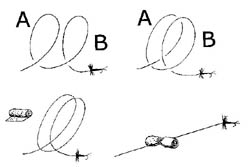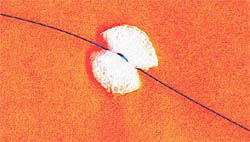"Strike Indicators for Dry Flies"
Adapted from The Essential Guide to Fly-Fishing
by Clive Schaupmeyer
A perpetual problem of dry fly anglers everywhere is being able to actually see the fly. On smooth water, with the sun at just the right angle (perhaps even already set) you can see a #20 midge. And your 6X tippet looks like a towr
ope as it bends the surface film. But lots of times it is hard to see even large flies. Looking into the sun is obviously a problem, but I find the worst days for seeing small dry flies are overcast days, when the water surface has a bright silvery sheen.
There are fly patterns that use white calf-tail hair for the wing, and they are usually easy to see. They are great if you are fishing to non-selective trout - meaning that the trout will eat them. However, if your highly visible p
attern is not what the trout are eating, you still have a problem. An indicator is a great option that most fly anglers don't use, but should at least consider.
I know there are lots of folks who deplore the use of indicators even for nymph fishing. And some will cringe at the suggestion that they use such a crutch for dry flies. Fine. Maybe you can see a #22 midge dry at 40 feet, but I ca
n't. There are a couple of fussy spots on my beloved Crowsnest River where, if there is one rainbow looking up, there are ten. One of these complex back-eddy-slack-seam spots requires a 40 foot cast. How do I know a rise over in the general direction is a
t my fly? My pea-size white foam indicator shows me the general vicinity of my fly and if it is tweaked, I lift the rod. Works for me.
Sure using an indicator is not something I prefer to do. But when I simply cannot see my dry fly, I use a small strike indicator tied to the tippet about 18 to 24 inches from the dry fly or emerger. The indicator helps in a couple
of ways. Since you'll be able to see the indicator, you have a general idea of where to look for your fly, and, as often as not, you'll be able to find it. However, if the fly is very small and the water glare is just so, the fly still may not be visible.
So the indicator is watched instead. If rises are few and far between, all you have to do is set the hook when anything rises near the indicator. If there are a few fish rising, you keep an eye solely on the indicator. If it stops or is jerked slightly,
you set the hook.
Of course, you can't use brightly colored, hard plastic foam indicators for this. They are great for nymph fishing, but they will spook rising fish. However, there are at least three types of indicators that will not scare fish. Yo
u can tie a bushy dry fly like an EH Caddisfly or Humpy a couple of feet from the smaller dry fly you are having difficulty seeing. There are a couple of ways to do this, but the simplest is to tie on the bigger fly first and then tie on a short piece of
tippet to the bend of the bushy fly. The smaller dry fly or emerger is then tied to the end of this piece of tippet. Personally, I don't like using a second large buoyant dry fly as an indicator for small flies, but some anglers do. On smoother water the
larger dry fly can make unacceptable waves that may spook the trout. I also feel that the larger fly can put spooky fish off their feed. I mean, how would you feel if you hadn't seen a big funny looking bug all day, and then suddenly one keeps coming by t
ime after time?
Yarn and packing foam can be used to make dry-fly indicators. Some anglers tie on small clumps of synthetic knitting or crocheting yarn. Phentex is a popular and cheap yarn used by fly tyers and fly-fishers. White Phentex - it's ma
de with something called olefin - is sometimes used for wings on spent spinner flies or upright wings instead of calf tail. Cut a 1-inch length and attach it to the tippet with a clove hitch or other suitable knot. Then trim it down to 1/2 inch. If you us
ed a clove hitch, you'll have to cut the tippet to remove the yarn. Phentex and other indicator yarns are available in specialty fly shops that sell fly-tying materials and fly-fishing supplies. Experiment with yarns in your home, but don't use wool or wo
ol blends for strike indicators as they absorb water and don't float for long.

The clove hitch is one way to attached closed-cell foam to the leader or
tippet. Loop A is made first. Loop B is then placed in front of Loop A by sliding it on front (not by flipping it over). The foam roll is inserted and the loops tightened on the foam. Excess foam is trimmed.
For small dry flies I prefer to use indicators made of closed-cell packing foam. You know what it is. It is the flexible closed-cell foam sheeting, usually less than 1/8 inch thick, used to pack electronic equipment.  The sheets are usually milky white, although there are pastel blue and pink sheets. The white foam doesn't spook even the wariest trout because it looks like natural foam on the water. Closed
-cell foam does not absorb water like other foams. The sheets are usually milky white, although there are pastel blue and pink sheets. The white foam doesn't spook even the wariest trout because it looks like natural foam on the water. Closed
-cell foam does not absorb water like other foams.
I cut sheets into small portions about 1 inch square and carry them in a small tin in my vest. Size doesn't matter a lot since the foam squares are easily trimmed to size with front teeth or scissors. A small square of the foam is
attached to the tippet, again, with a clove-hitch knot. When used as a dry-fly indicator the foam is trimmed down to pea size, or smaller. To remove the foam, gently but firmly pull on the tippet line from both sides. Usually the line shears the soft foam
. Sometimes the tippet breaks, but worse things happen.
Closing thought: No matter what happens, there is always someone who knew it would.
Return to Index
Copyright ©1998 Clive Schaupmeyer
Clive Schaupmeyer is an outdoor writer and photographer. He is the author of
The Essential Guide to Fly-Fishing,
a 288-page book for novice and intermediate fly anglers. His photo of a boy
fishing was judged the best outdoor picture of 1996 published by a member of
the Outdoor Writers of Canada. He fly-fishes for trout in Alberta's foothill
and mountain streams and for pike near his home in Brooks, Alberta.
Our Man In Canada Archives
|



